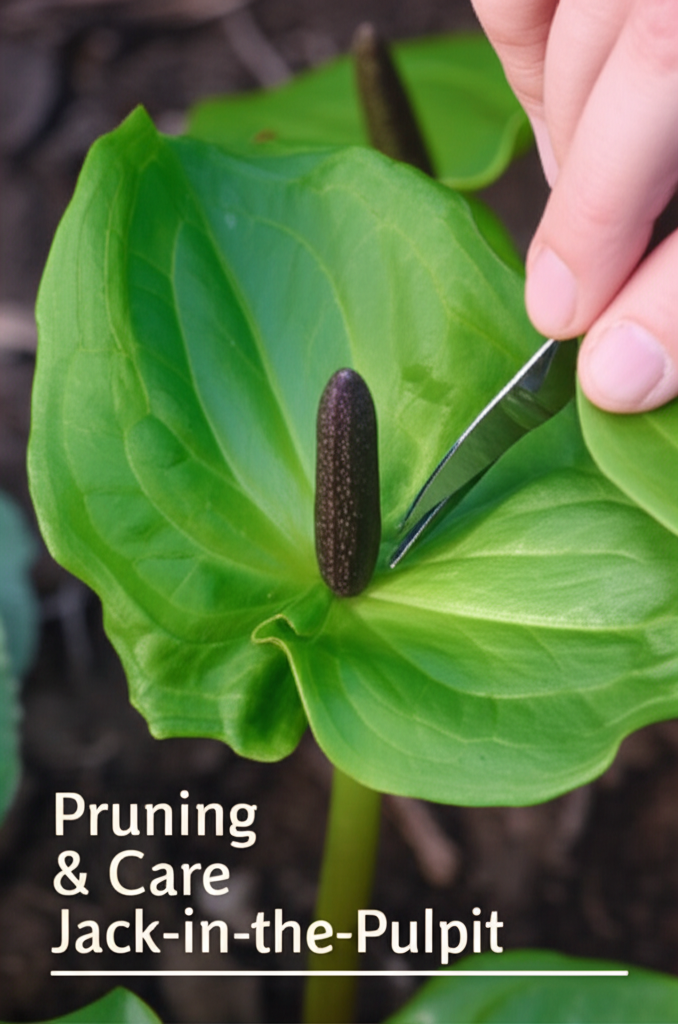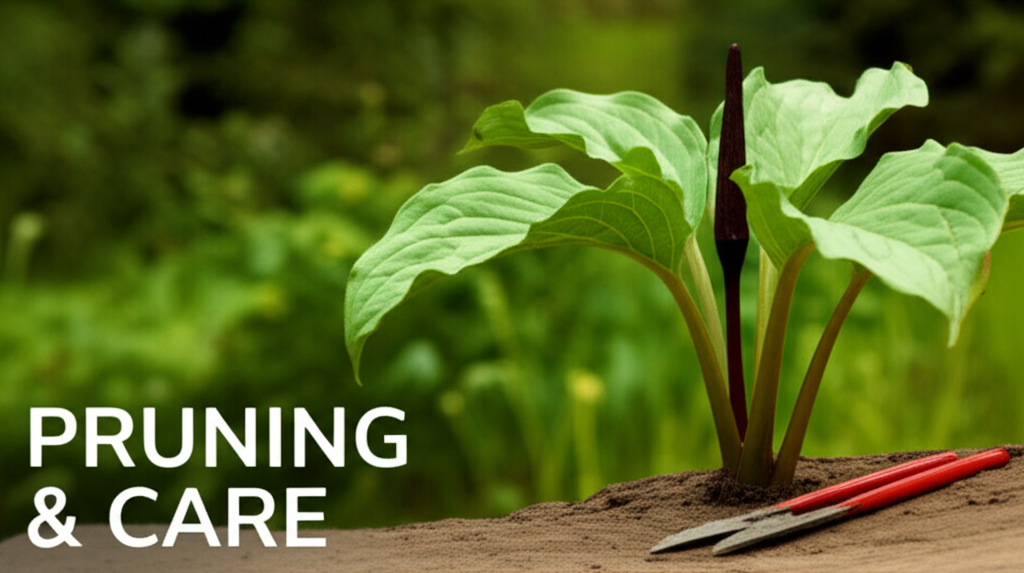Understanding Jack-in-the-Pulpit: A Unique Woodland Native
Jack-in-the-Pulpit (Arisaema triphyllum) is a fascinating and distinctive native wildflower found throughout eastern North America. Its common name derives from the unique spathe (a hooded leaf-like structure) that enfolds the spadix (a fleshy spike bearing the tiny flowers). This plant is a true woodland gem, thriving in dappled shade and moist, humus-rich soil. While not typically requiring extensive pruning in its natural habitat, understanding its life cycle and occasional maintenance needs can significantly enhance its health and appearance in a garden setting.
This guide will delve into the specific pruning and general care routines necessary to keep your Jack-in-the-Pulpit specimens flourishing, ensuring their characteristic charm continues to grace your shady corners.
When to Prune Jack-in-the-Pulpit: A Seasonal Approach

Unlike many ornamental plants that demand regular shaping, Jack-in-the-Pulpit has a more relaxed pruning schedule. The key is to understand its natural growth and dormancy cycle.
Post-Bloom Care: The Most Crucial Pruning Step
The most significant “pruning” activity for Jack-in-the-Pulpit occurs after the plant has finished flowering and has set its berries. During this phase, the plant is actively channeling energy into developing its seed structure.
- Deadheading Spent Flower Stalks: Once the distinctive spathe and spadix have faded and begun to wither, it’s beneficial to remove the spent flower stalk. This prevents the plant from expending unnecessary energy on non-viable seeds and can improve the overall tidiness of the plant. The removal should be done cleanly, cutting the stalk at the base, close to where it emerges from the soil.
- Allowing Foliage to Yellow: It is absolutely critical to allow the leaves and the remaining stalk to yellow and die back naturally. This foliage is essential for photosynthesis, replenishing the energy stored in the corm for the following year’s growth. Removing the foliage prematurely will weaken the plant and can prevent it from blooming or even surviving.
Seasonal Cleanup: Addressing Winter Dormancy
As autumn progresses and temperatures drop, the foliage of Jack-in-the-Pulpit will naturally turn yellow and then brown before collapsing.
- Spring Cleanup: In early spring, before new growth emerges from the soil, it’s a good time to perform a general cleanup of any remaining dead plant material from the previous season. This includes any dried leaves or stems that may have persisted through the winter. This tidying-up improves air circulation around the emerging shoots and prevents potential disease issues.
- Avoid Disturbance: It’s important to minimize soil disturbance around the corm during this cleanup, as new shoots are delicate and easily damaged.
Jack-in-the-Pulpit Care Routines: Cultivating Success
Beyond pruning, several care routines contribute to the thriving health of Jack-in-the-Pulpit. These practices mimic its natural woodland environment.
Light Requirements: Dappled Shade is Ideal
Jack-in-the-Pulpit prefers dappled shade or partial shade. This means areas that receive bright, indirect light for several hours a day, but are protected from harsh, direct afternoon sun.
- Woodland Gardens: Underneath deciduous trees or shrubs that provide a leafy canopy is an excellent location.
- Eastern Exposures: Morningside locations that receive gentle morning sun and afternoon shade are also well-suited.
- Avoid Full Sun: Direct, intense sunlight can scorch the leaves and dry out the soil too quickly, stressing the plant.
- Avoid Deep Shade: While it tolerates shade, very deep shade with minimal light might lead to weaker growth and fewer blooms.
Soil and Moisture: The Foundation of Health
The Jack-in-the-Pulpit is accustomed to the rich, moist, and well-drained soils found on forest floors. Replicating these conditions is paramount.
- Rich Organic Matter: The soil should be amended generously with compost, leaf mold, or other organic materials. This improves soil structure, fertility, and water retention.
- Moisture Retention: Consistent moisture is crucial, especially during the growing season. The soil should be kept evenly moist, but not waterlogged.
- Drainage: While it likes moisture, good drainage is essential to prevent the corm from rotting. Avoid heavy clay soils that retain too much water. Raised beds or amending with grit can improve drainage in problematic soils.
- Mulching: A layer of organic mulch, such as shredded bark, compost, or leaf litter, applied around the base of the plant (but not touching the stem) helps to retain soil moisture, suppress weeds, and regulate soil temperature.
Watering Practices: Consistency is Key
The watering needs of Jack-in-the-Pulpit will vary depending on rainfall and environmental conditions.
- During Growth and Bloom: Water regularly to keep the soil consistently moist.
- Dormancy Period: Once the foliage has died back in late summer or autumn, watering can be reduced significantly. The corm enters a dormant phase and requires less moisture. However, in prolonged dry spells, a light watering may still be beneficial.
- Check Soil Moisture: The best way to determine if watering is needed is to feel the soil. If the top inch or two feels dry, it’s time to water.
Fertilizing: Minimal Intervention
Jack-in-the-Pulpit is not a heavy feeder and typically thrives in fertile, organic-rich soil with minimal fertilization.
- Annual Top-dressing: A light top-dressing of compost or well-rotted manure in early spring, before new growth emerges, is usually sufficient.
- Avoid Over-fertilizing: Excessive fertilizer, especially high-nitrogen varieties, can lead to leggy growth, reduced flowering, and increased susceptibility to pests and diseases.
Pest and Disease Management: Vigilance and Prevention
Jack-in-the-Pulpit is generally a robust plant with few significant pest or disease problems when grown in suitable conditions.
- Common Pests: Slugs and snails can sometimes be a problem, especially for young shoots. Copper tape around planting beds or organic slug baits can be effective.
- Deer and Other Wildlife: In some areas, deer or other herbivores may browse on the foliage. If this is a concern, protective fencing or deterrents may be necessary.
- Root Rot: The most common issue is root rot, which is almost always caused by overwatering or poorly drained soil. Ensuring proper soil conditions is the best preventative measure.
- Leaf Spotting: Occasionally, fungal leaf spots may appear, particularly in very humid conditions or if the foliage remains wet for extended periods. Good air circulation and avoiding overhead watering can help mitigate this. Prompt removal of affected leaves can also prevent spread.
Propagation: Expanding Your Jack-in-the-Pulpit Collection
Jack-in-the-Pulpit can be propagated from seed or by dividing the corms.
From Seed
- Collection: Collect the bright red berries in late summer or early autumn.
- Sowing: Sow seeds immediately in a moist, well-draining seed-starting mix. They require a period of cold stratification (a period of chilling) to germinate. This can be achieved by sowing them outdoors in autumn or by storing them in the refrigerator in a slightly moist medium over winter.
- Germination: Germination can be slow and erratic, often taking one to two years. Seedlings will be small and will take several years to reach flowering size.
By Corm Division
- Timing: The best time to divide Jack-in-the-Pulpit corms is in late summer or early autumn, after the foliage has died back but before the ground freezes.
- Process:
1. Carefully dig up the corms, trying not to damage them.
2. Gently brush away excess soil.
3. If the corm has multiple sections or offsets, carefully separate them. Each section should have at least one growing point or “eye.”
4. Replant the divisions immediately in their new locations, ensuring they are planted at the same depth they were previously growing.
5. Water thoroughly after planting.
Key Facts and Comparison
Here’s a table summarizing essential information about Jack-in-the-Pulpit and comparing it to a common shade-loving perennial.
| Feature | Jack-in-the-Pulpit (Arisaema triphyllum) | Hosta (Various cultivars) |
|---|---|---|
| Native Range | Eastern North America | East Asia |
| Light Preference | Dappled to partial shade | Partial shade to full shade (varies by cultivar) |
| Soil Preference | Moist, humus-rich, well-drained | Moist, well-drained, adaptable |
| Pruning Needs | Minimal; deadhead spent flower stalk, allow foliage to die back naturally | Cut back dead foliage in late fall or early spring |
| Primary Appeal | Unique spathe/spadix flower structure, red berries, woodland aesthetic | Varied foliage color, texture, and size; often attractive flowers |
| Watering | Consistently moist during growth, reduced during dormancy | Consistently moist |
| Fertilizing | Light compost top-dressing in spring | Moderate fertilization or compost |
| Pest/Disease Susceptibility | Low; susceptible to slugs/snails, root rot if overwatered | Moderate; susceptible to slugs, snails, hosta virus X |
Pruning and Care: A Step-by-Step Overview
This table outlines the general steps involved in pruning and essential care routines for Jack-in-the-Pulpit.
| Stage | Action | Description | Pros | Cons |
|---|---|---|---|---|
| Spring (Early) | Cleanup | Remove any dead foliage from the previous year. | Improves air circulation, tidies appearance. | Risk of damaging emerging shoots if not careful. |
| Check Soil Moisture | Ensure soil is moist but not waterlogged. | Supports new growth emergence. | Overwatering can lead to corm rot. | |
| Late Spring/Summer (During Growth) | Watering | Maintain consistent soil moisture. | Promotes healthy leaf and flower development. | Requires regular attention, especially in dry periods. |
| Observe for Pests | Inspect for slugs, snails, or other pests. | Early detection prevents significant damage. | Requires vigilance. | |
| Late Summer/Early Autumn (Post-Bloom) | Deadheading | Remove spent flower stalks. | Redirects plant energy to corm and seed development, tidies appearance. | Only do this after flowering has completely finished. |
| Allow Foliage to Yellow | Do NOT remove green foliage. | Essential for corm replenishment. | Plant looks untidy as foliage dies back. | |
| Autumn/Winter (Dormancy) | Mulching | Apply a layer of organic mulch. | Retains moisture, insulates corm, suppresses weeds. | Ensure mulch is not in direct contact with the stem. |
| Reduce Watering | Water only if prolonged dry spells occur. | Prevents corm rot during dormancy. | Extreme drought could still stress the dormant corm. | |
| Occasional | Corm Division | Divide overgrown corms in late summer/early autumn. | Propagates new plants, rejuvenates the parent plant. | Requires careful handling, risk of corm damage. |
Troubleshooting Common Issues
Even with the best care, you might encounter a few common issues with your Jack-in-the-Pulpit.
Yellowing Leaves
- During the growing season: If leaves turn yellow prematurely and the plant isn’t finished with its cycle, it could indicate lack of moisture, insufficient light, or nutrient deficiency (though rare). Ensure it’s getting adequate water and dappled shade.
- In late summer/autumn: This is normal. The plant is naturally dying back to prepare for dormancy. Allow it to complete this process.
Lack of Flowers
- Young Plants: Jack-in-the-Pulpit plants need a few years to mature from seed or division before they reliably flower. Be patient.
- Inadequate Light: If planted in too deep shade, flowering may be reduced.
- Poor Corm Health: If the corm is weak due to poor soil, insufficient moisture during growth, or damage, it may not have enough energy to produce a flower.
Rotting Corms
- Cause: This is almost always due to overwatering or poorly draining soil.
- Solution: Ensure the planting location has good drainage. If you suspect rot, gently excavate the corm, trim away any soft, black, or mushy parts with a clean knife, and replant in well-draining soil. Avoid watering until the soil is dry to the touch.
Conclusion: Nurturing a Woodland Wonder
Caring for Jack-in-the-Pulpit is a rewarding experience that requires attentiveness to its natural rhythms rather than aggressive intervention. By understanding its preference for dappled shade, moist, organic soil, and by adhering to the simple “pruning” of removing spent flower stalks and allowing foliage to naturally die back, you can ensure this captivating woodland native thrives. Minimal fertilization and vigilant, but not excessive, watering will further contribute to its health. Embrace the unique beauty of Jack-in-the-Pulpit, and it will undoubtedly become a treasured feature of your shade garden.


